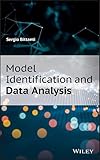Model identification and data analysis / Sergio Bittanti, Politecnico di Milano, Milan, Italy.
By: Bittanti, Sergio [author.] .
.
Material type:  BookPublisher: Hoboken, NJ : John Wiley & Sons, Inc., 2019Copyright date: ©2019Description: 1 online resource (xvi, 399 pages).Content type: text Media type: computer Carrier type: online resourceISBN: 9781119546313; 1119546311; 9781119546412; 1119546419; 9781119546405; 1119546400.Subject(s): Mathematical models
BookPublisher: Hoboken, NJ : John Wiley & Sons, Inc., 2019Copyright date: ©2019Description: 1 online resource (xvi, 399 pages).Content type: text Media type: computer Carrier type: online resourceISBN: 9781119546313; 1119546311; 9781119546412; 1119546419; 9781119546405; 1119546400.Subject(s): Mathematical modelsIncludes bibliographical references and index.
Cover; Title Page; Copyright; Contents; Introduction; Acknowledgments; Chapter 1 Stationary Processes and Time Series; 1.1 Introduction; 1.2 The Prediction Problem; 1.3 Random Variable; 1.4 Random Vector; 1.4.1 Covariance Coefficient; 1.5 Stationary Process; 1.6 White Process; 1.7 MA Process; 1.8 AR Process; 1.8.1 Study of the AR(1) Process; 1.9 Yule-Walker Equations; 1.9.1 Yule-Walker Equations for the AR(1) Process; 1.9.2 Yule-Walker Equations for the AR(2) and AR(n) Process; 1.10 ARMA Process; 1.11 Spectrum of a Stationary Process; 1.11.1 Spectrum Properties
1.11.1.0 Proof of the Spectrum Properties1.11.2 Spectral Diagram; 1.11.3 Maximum Frequency in Discrete Time; 1.11.4 White Noise Spectrum; 1.11.5 Complex Spectrum; 1.12 ARMA Model: Stability Test and Variance Computation; 1.12.1 Ruzicka Stability Criterion; 1.12.2 Variance of an ARMA Process; 1.13 Fundamental Theorem of Spectral Analysis; 1.14 Spectrum Drawing; 1.15 Proof of the Fundamental Theorem of Spectral Analysis; 1.16 Representations of a Stationary Process; Chapter 2 Estimation of Process Characteristics; 2.1 Introduction; 2.2 General Properties of the Covariance Function
2.3 Covariance Function of ARMA Processes2.4 Estimation of the Mean; 2.5 Estimation of the Covariance Function; 2.6 Estimation of the Spectrum; 2.7 Whiteness Test; Chapter 3 Prediction; 3.1 Introduction; 3.2 Fake Predictor; 3.2.1 Practical Determination of the Fake Predictor; 3.3 Spectral Factorization; 3.4 Whitening Filter; 3.5 Optimal Predictor from Data; 3.6 Prediction of an ARMA Process; 3.7 ARMAX Process; 3.8 Prediction of an ARMAX Process; Chapter 4 Model Identification; 4.1 Introduction; 4.2 Setting the Identification Problem; 4.2.1 Learning from Maxwell
4.2.2 A General Identification Problem4.3 Static Modeling; 4.3.1 Learning from Gauss; 4.3.2 Least Squares Made Simple; 4.3.2.1 Trend Search; 4.3.2.2 Seasonality Search; 4.3.2.3 Linear Regression; 4.3.3 Estimating the Expansion of the Universe; 4.4 Dynamic Modeling; 4.5 External Representation Models; 4.5.1 Box and Jenkins Model; 4.5.2 ARX and AR Models; 4.5.3 ARMAX and ARMA Models; 4.5.4 Multivariable Models; 4.6 Internal Representation Models; 4.7 The Model Identification Process; 4.8 The Predictive Approach; 4.9 Models in Predictive Form; 4.9.1 Box and Jenkins Model; 4.9.2 ARX and AR Models
4.9.3 ARMAX and ARMA ModelsChapter 5 Identification of Input-Output Models; 5.1 Introduction; 5.2 Estimating AR and ARX Models: The Least Squares Method; 5.3 Identifiability; 5.3.1 The R Matrix for the ARX(1, 1) Model; 5.3.2 The R Matrix for a General ARX Model; 5.4 Estimating ARMA and ARMAX Models; 5.4.1 Computing the Gradient and the Hessian from Data; 5.5 Asymptotic Analysis; 5.5.1 Data Generation System Within the Class of Models; 5.5.2 Data Generation System Outside the Class of Models; 5.5.2.1 Simulation Trial; 5.5.3 General Considerations on the Asymptotics of Predictive Identification
Online resource; title from digital title page (viewed on April 08, 2019).
This book is about constructing models from experimental data. It covers a range of topics, from statistical data prediction to Kalman filtering, from black-box model identification to parameter estimation, from spectral analysis to predictive control. Written for graduate students, this textbook offers an approach that has proven successful throughout the many years during which its author has taught these topics at his University. The book: -Contains accessible methods explained step-by-step in simple terms -Offers an essential tool useful in a variety of fields, especially engineering, statistics, and mathematics -Includes an overview on random variables and stationary processes, as well as an introduction to discrete time models and matrix analysis -Incorporates historical commentaries to put into perspective the developments that have brought the discipline to its current state -Provides many examples and solved problems to complement the presentation and facilitate comprehension of the techniques presented.


There are no comments for this item.